Menu
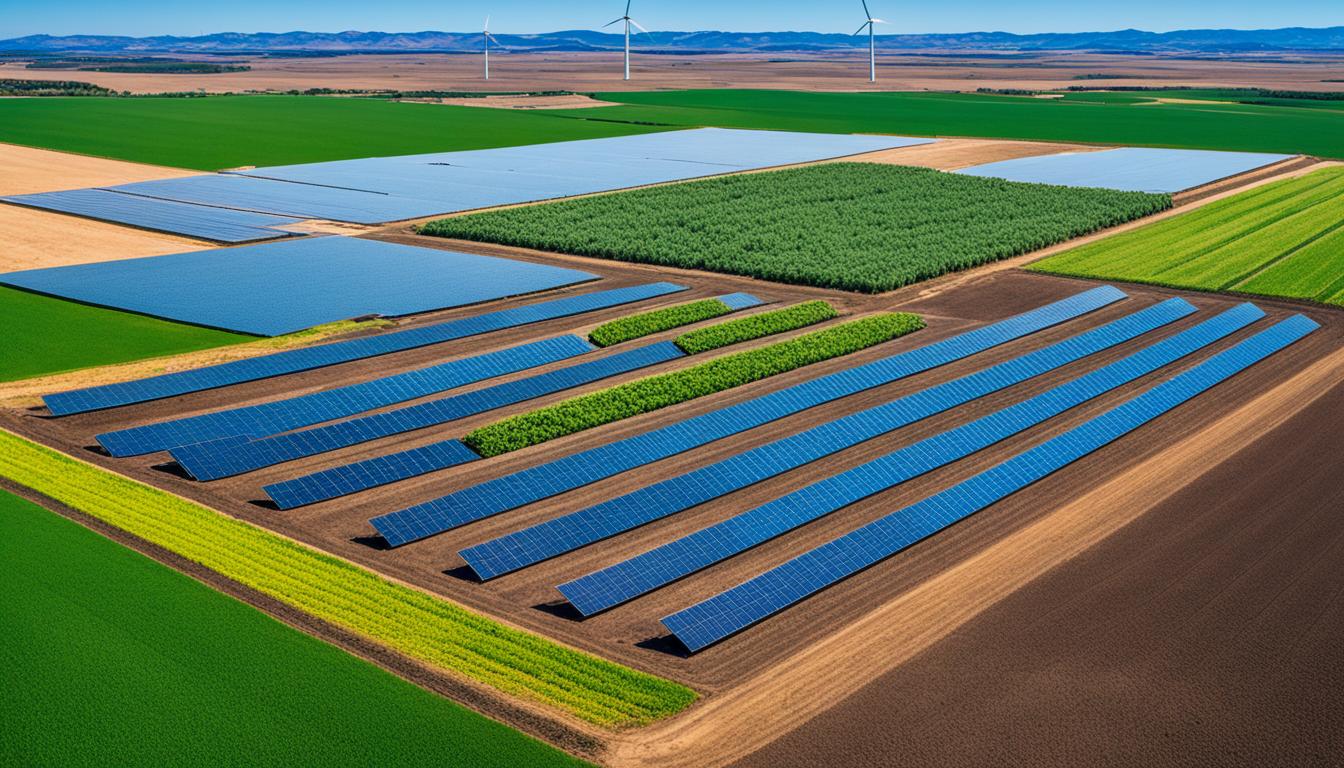
Did you know the market for global soil monitoring is set to hit USD 1,598.78 million by 2030? It’s growing fast, with a CAGR of 13.9% from 2022 to 2030. This fast growth is thanks to new soil health monitoring tech that’s changing agriculture’s future.
Startups like Farmsys from India and N-Sense in the US are using the Internet of Things (IoT) in soil sensors. This makes the sensors more advanced, giving farmers very accurate data on soil conditions like moisture and pH. These insights help with saving the environment and in making smarter decisions about their land.
Innovations like soil analysis, aerial imaging, and figuring out soil characteristics from above are also helping a lot. They cut down risks and help increase the amount of crops farmers get. All of this tech is making it easier to understand and manage soil health for better farming.
Improving soil health tech is tackling big stains in checking soil quality. It combines IoT, immersive tech, robots, blockchains, and tiny tech to improve how we manage land and farm in a better way. The future is looking good for farming, with experts spotting top trends that will help manage soil better.
In 2024, the farming world is changing with new soil management strategies. High-tech tools are key in farming sustainably. They include sensors for instant data and aerial tech for better views. Together, they’re improving how we take care of the land thoroughly.
Many are now using methods like no-till and conservation tillage on huge areas of crops. This covers 96 million and 77 million acres respectively. It’s a big move towards keeping the soil healthy and the ways we farm lasting.
IoT soil sensors are a big part of this change. They let farmers check the soil all the time. Then, they can adjust water and nutrient use just right. This helps crops grow better and uses less of our resources.
Tech like drones and satellites are proving their worth too. They give farmers a full view of the soil’s condition. This quick look can reveal problems like erosion early on. So, farmers can fix things fast and keep the land productive.
All these tools are adding up to a market that might hit $1598.78 million by 2030. That’s a sign of how much we value keeping our soil healthy in farming.
In organic farming that uses no-till methods with cover crops, there are some big challenges. Fewer than 10% of the US fields using no-till have enough cover crops. This shows there’s a big chance to do more and farm in ways that don’t harm the land.
These modern soil strategies are in line with what the United Nations suggests for farming. They focus on making the soil healthier. This includes using cover crops, not disturbing the soil (no-tillage), changing which crops we grow, and mixing in livestock. All these help the soil in key ways.
It’s important to keep track and learn from our soil care efforts. By knowing what works best, farmers can reach their growing and money goals. At the same time, they can protect the environment.
| Practice | Acres Implemented (Millions) | Benefits | Challenges |
|---|---|---|---|
| No-till | 96 | Improved soil structure, reduced erosion | Potential for increased weed competition |
| Conservation Tillage | 77 | Better water retention, enhanced nutrient retention | Yield reduction due to residual cover crops |
| Cover Crops | 17.3 (10%) | Improves soil organic matter, biomass accumulation | Requires high biomass to be effective |
It’s a turning point in 2024 for how we look after the soil. Mixing new tech with what we already know is vital. It helps us farm in ways that look after the soil and our future. This is crucial with the environment’s challenges. We must keep our soil healthy for farming to continue well.
The world of soil monitoring is changing fast. New technologies are making a big difference in farming. Farmers now need to check on their soil’s health more often. This helps them farm better and get more crops. The market for soil monitoring is growing. It’s expected to hit USD 1598.78 Million by 2030. This growth would move at a rate of 13.9% from 2022 to 2030. In this piece, we look at new soil sensors, aerial imaging, and high-tech soil analysis.
Soil sensors have changed how farmers look after their soil. Placed in the ground, these gadgets send data to farmers in real time. They measure things like temperature, humidity, and wetness. For example, Farmsys from India makes Soil Spectra. It looks at soil moisture, the NPK ratio, pH, and the weather. These tools help farmers use fertilisers and fight pests better. This makes the soil healthier.
Drones and satellites are making maps from up high. This flying tech shows problems with the soil and the health of crops. TerraRad, a startup from Switzerland, uses drones that study topsoil with special antennas. These drones make maps showing where the soil is the wettest. For another example, in the US, Map My Crop uses satellites and special light reflection to map soil productivity.
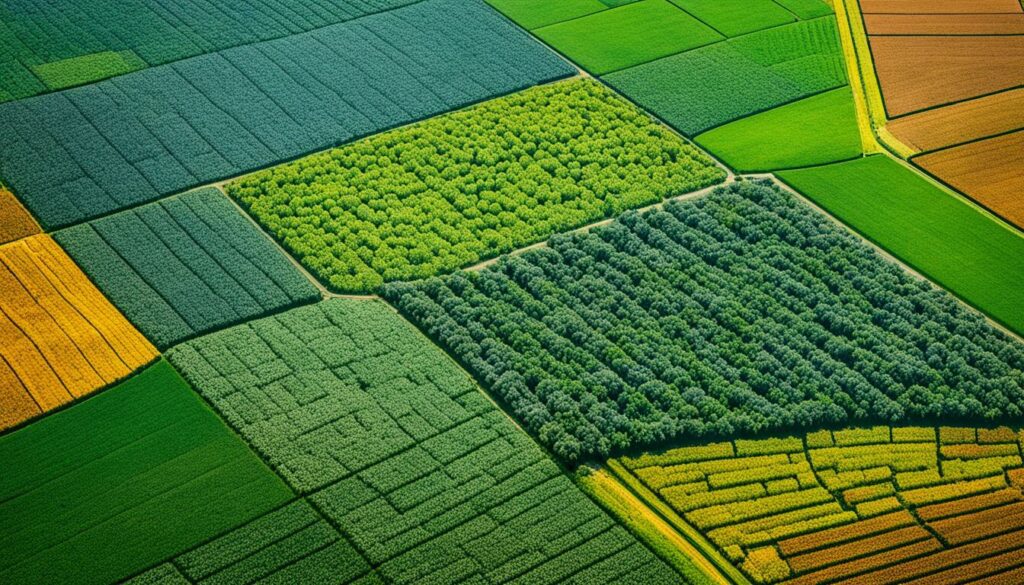
Special tools are making it possible to see deeper into the soil. With these tools, farmers can check soil moisture and carbon more closely. N-Sense, a startup in the US, uses special light to look at nitrates in the soil. Anton Tech in Botswana uses a method called hyperspectral imaging. This, along with computer learning, checks for pests, diseases, and changes in the carbon in the soil.
These new technologies are vital for modern farming. Soil sensors, aerial mapping, and detailed soil checks all help farmers manage their land better. This leads to better crops and sustainable farming.
| Startup | Specialisation | Technology Used | Key Benefit |
|---|---|---|---|
| Farmsys | Soil Monitoring | IoT Soil Sensors | Real-time data on essential soil parameters |
| N-Sense | Soil Nitrate Detection | Fourier-transform Infrared Spectroscopy | Accurate nitrate level analysis |
| SoilSerdem | Soil Fertility Mapping | Remote Sensing, GIS-Based Mapping | Precise soil quality assessment |
| Map My Crop | Soil Productivity Mapping | Satellite Measurements, Electromagnetic Radiation | Detailed soil productivity data |
| TerraRad | Topsoil Monitoring | Drone-based L-band Radio Wave Antennas | High-resolution subsurface moisture maps |
| Anton Tech | Soil Carbon Monitoring | Hyperspectral Imaging, Machine Learning | Detection of pests, diseases, and soil carbon levels |
IoT is changing how we manage soil in farming. It offers unmatched precision and efficiency. This is crucial as 33% of global soils are already degraded. The Food and Agriculture Organization warns us about the risks of soil damage.
Getting up-to-the-minute soil data is key for today’s farms. IoT tools like soil sensors watch over the soil’s moisture, temperature, and nutrients. This data lets farmers act fast and farm efficiently. They use modern farming methods to boost crops’ health and growth.
Perfecting how we water crops is vital for the future of farming. IoT-linked watering systems adjust water use by checking the soil’s moisture and weather conditions. This saves water and helps crops grow better.
In the US, soil erosion alone causes a $44 billion loss every year. Using IoT for water management can cut down these losses. The agriculture IoT market is expected to jump from $11.4 billion in 2021 to $18.1 billion by 2026. This shows how much we will rely on these techs to keep our soils healthy.
| Statistic | Detail |
|---|---|
| Degraded Global Soils | 33% (FAO) |
| Potential Arable Land Loss | 100% in 60 years (United Nations) |
| Annual US Loss Due to Soil Erosion | $44 billion |
| IoT Market Growth in Agriculture | $11.4 billion in 2021 to $18.1 billion by 2026 |
IoT technology plays a big role in keeping our soils healthy. It allows for monitoring soil in real time and smart water use. This saves resources and helps farming thrive for the long term.
Building soil health is vital for countering climate change’s negative effects. It’s especially essential in dry areas. 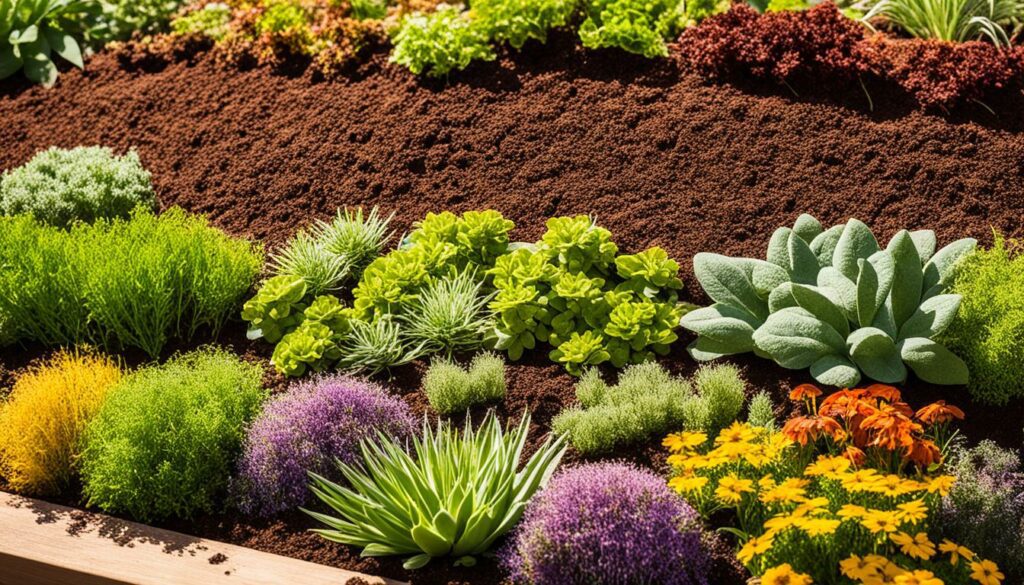
Helping soil cope with droughts is key to dealing with climate change. Techniques like no-till farming and planting cover crops preserve yields. They also make soil better at saving water, which helps plants survive when it’s dry. This approach saves farmers time and money by making them ready for droughts.
Soil health is also great for handling floods. Healthy soil absorbs and keeps more water during heavy rains, lowering flood risks. To enhance this ability, farmers can add organic materials and improve soil’s structure. This makes the land better at preventing floods and protecting water quality. Before floods, these methods can protect crops and the environment.
In 2024, sustainable farming practices have advanced, especially with organic farming techniques. Farmers now use natural ways to control pests and manage nutrients. This leads to much less use of chemicals. Their aim is to farm in a way that’s good for the environment and the farm’s productivity.
Organic farming is key in today’s agriculture. It avoids using synthetic pesticides and fertilisers, creating a more natural setting. Methods like growing different crops in turns, using certain crops to protect others, and planting beneficial plants together, help the land stay healthy. This also attracts helpful insects and animals, making the farm more diverse.
Sustainable farming means using fewer chemicals. Methods like not ploughing the land, planting different crops together, and growing plants that attract insects, reduce harm to the environment. For example, planting flowering crops between rows can increase the number of songbirds. It also helps trees and vines have a more varied and rich area around them, which lasts all year.
| Practice | Benefits |
|---|---|
| Cover Cropping | Controls erosion, reduces nutrient runoff, and suppresses weed growth. |
| Windbreaks | Reduces wind velocity and protects crops for vast areas. |
| No-Till Systems | Lowers greenhouse gas emissions and benefits insect populations. |
| Agroforestry | Integrates trees and shrubs into crops and livestock for ecological benefits. |
With more people wanting products made in sustainable ways, farmers are changing how they farm. Efforts from farmers, researchers, and policymakers are helping. Plus, support programmes encourage farmers to choose eco-friendly agriculture. This teamwork and new strategies are steering the agriculture industry to a greener and more stable future.
Soil biodiversity is key to keeping our ecosystems healthy. It’s vital for farming too. A whopping 59% of Earth’s species are found in the soil. This shows why we must protect it.
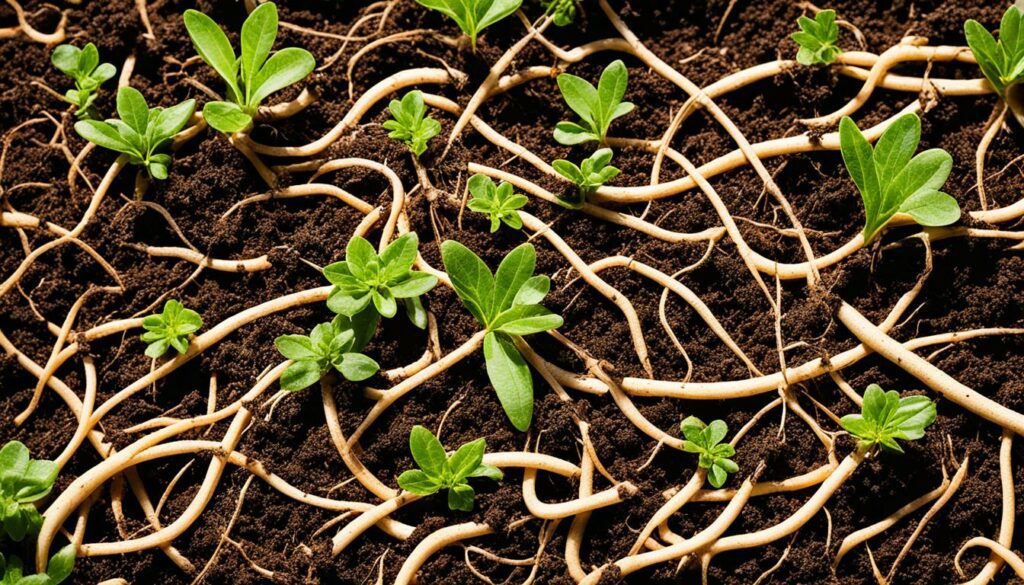
Many things live in the soil, like fungi, bacteria, and earthworms. They help recycle nutrients. Earthworms are especially important, supporting 6.5% of the world’s grain. They also help keep pests and diseases in check, saving crops.
But, soil health is in danger. 75% of the world’s soils are getting worse. This might reach 90% by 2050. Protecting soil life is crucial to keep ecosystems and farms working well.
New tech like soil ecoacoustics is a game-changer. It listens to sounds from soil life to find out how healthy the soil is. This tech is seen as very important for keeping an eye on biodiversity trends.
Labs are also improving how they check soil. They look at things like the living things in the soil, how the soil breathes, and its acidity. This helps us understand soil health better. It’s key for looking after soils.
There’s also a big push for soil-friendly products. Things like carbon boosters and biostimulants are being developed. These products aim to make soil healthier, supporting more life.
Looking after soil life is really important. Soil holds a lot of carbon. How we care for it affects the planet’s climate. Investment in saving soil life now is crucial for future farming.
Predictive soil mapping is changing how we look after soil. This tech uses AI to study soil and drones to map it out accurately. It helps spot soil problems early, so farmers can fix them fast. This means they can use the right amount of fertiliser to grow more crops.
In the US, startups like SoilSerdem use computers to make maps showing where soil is fertile. Another company, Map My Crop, uses satellites to see how productive the land is. These tools help farmers use just what they need to grow well, based on the soil under their feet.
Adding drones to the mix lets farmers keep a close eye on their soil in real time. Companies such as TerraRad and Anton Tech are making drones that can measure soil moisture and carbon. This information helps farmers keep their soil in top shape, which boosts how much food they can grow.
Using AI for soil studies does more than make maps. It helps farmers understand their soil better. With this deep knowledge, they can grow crops smarter, avoiding diseases and harm from the changing climate.
Predictive soil mapping is set to grow big by 2030, with a predicted market worth a lot of money. Companies like Farmsys and N-Sense are already seeing more business. They sell high-tech sensors that keep an eye on key soil info.
In the future, AI and better drone tech will give us even clearer views of our soil. This will mean farmers can use their land more carefully. It’s good for growing crops and taking care of the planet too.
The market for soil amendments is growing fast. It’s set to reach USD xx.x Billion by 2031. This increase is because more people want to use these products to make soil healthier. Technologies are also getting better, helping us use these amendments more effectively.
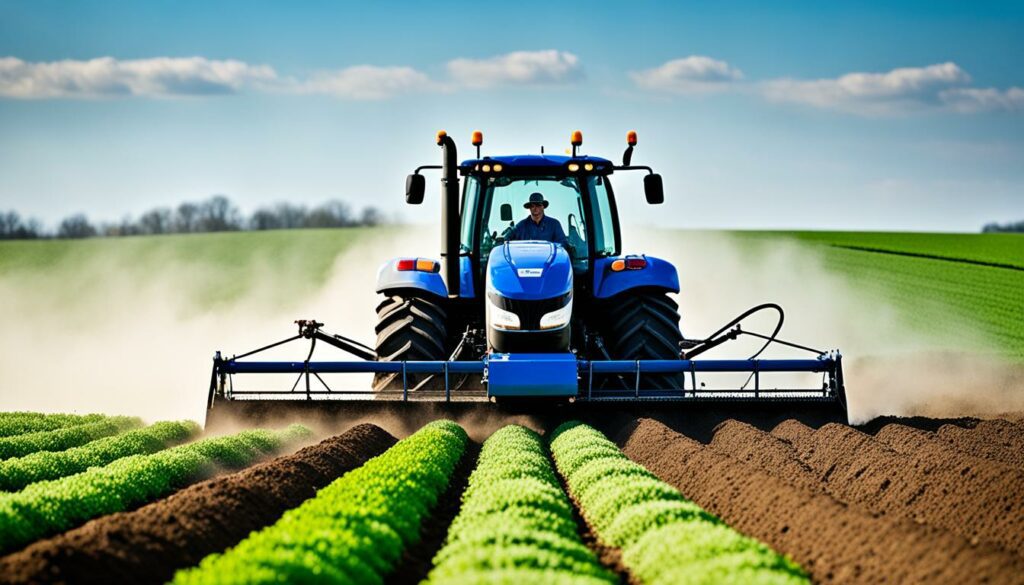
Things like compost and manure are key for better soil. They make soil hold water, stop erosion, and help good microbes grow. They also help crops absorb nutrients well. This choice is very popular with farmers who care about the environment.
Then there are chemical fertilisers and soil conditioners. They let us fine-tune the nutrients in the soil. They quickly fix nutrient problems, boosting how much crops give us. Even though they can be costly at first and need to meet rules, they are very efficient.
| Type | Application | Key Players |
|---|---|---|
| Natural | Agricultural, Gardening | BASF SE, Bayer CropScience |
| Synthetic | Landscaping, Agricultural | Syngenta AG, Novozymes A/S |
Natural and synthetic soil amendments are both vital. They help in different ways to make plants strong. Big companies like BASF SE and Syngenta AG are working hard to make new and better soil products. All this helps soil and crops do well.
Advanced soil health strategies are changing farming. They bring big economic advantages. Farmers save money, use resources better, and lower their impact on the environment. Sustainable steps like smart fertilising and feeding the soil well boost how much crops grow.
These methods cut the costs of using chemicals. Take the target from the 2006 Abuja Declaration, which suggests using 50 kilograms of fertiliser per hectare. Many African countries struggle to reach this, using only 18 kilograms per hectare on average. However, places that use advanced soil strategies make their fertiliser go further. This saves them money and helps the environment.
Crops grow better thanks to these strategies. By using balanced nutrition and checking the soil, maize farmers can avoid their yields levelling off. Soil checks make sure crops get the right nutrients. For example, adding certain things to the soil really works. Morocco and Egypt are great examples, as they went past the 50kg/ha target easily with 55.29 kg/ha and 542.57 kg/ha.
The table below shows how African countries compare in using fertiliser. It points out why using advanced soil health plans can be so helpful:
| Country | Fertiliser Consumption (kg/ha) | Target (50 kg/ha) |
|---|---|---|
| Morocco | 55.29 | Surpassed |
| Egypt | 542.57 | Surpassed |
| Kenya | 18 (Only 18% arable land) | Below |
| Average Across 40 Countries | 18 | Below |
Using these advanced soil strategies can really change agriculture. They help farmers save money and grow more crops. This not only makes farmers financially stronger. It also supports the use of methods that are good for the land and continue to work well over time.
Soil health is set for big improvements by 2024, thanks to new technologies. Things like biotechnology, artificial intelligence, and predicting soil health are changing how we look after the land. This is all going to make farming smarter.
In the area of soil health, future tech is making a big difference. The market for improving soil was worth US$40.7 billion in 2022. It’s expected to hit US$57.1 billion by 2028. That’s a 4.5% increase each year.
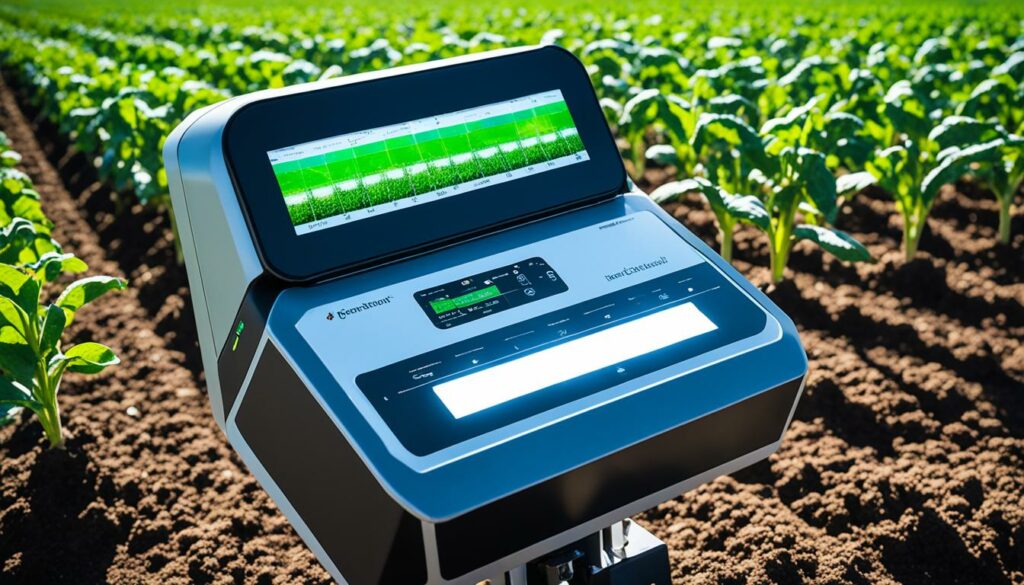
New tech like nitrogen fixation, microbial phosphorus solubilization, and potassium solubilization are boosting soil nutrients. This is key for growing plants well and farming more efficiently.
The future of farming is all about being able to sustain it for the long haul. Tech for testing soil was worth US$13.72 billion in 2022. It’s meant to reach US$19.02 billion by 2029, growing at 4.78% each year. Efforts by the EU and the U.S. to protect soil health show the global push for sustainable farming.
There’s also a big focus on tackling soil problems like acidification and alkalinization. This requires using different methods like science and nature to fix the soil. Working on these issues is important to ensure we keep producing food while protecting the environment.
Both public and private sectors are now keen on improving soil health. They want to use sustainable farming and make our food supply more secure. Together, they are working hard on two fronts: the public sector is focusing on soil health, while private companies are pushing agriculture forward.
Government policies are crucial. Their goal by 2034 is to give advice tailored for small farmers on crops, soils, and climates. They also aim to make more fertilizers available thanks to the Africa Fertilizer Financing Mechanism (AFFM). This will help both organic and non-organic fertilizers be made and shared more.
The Soil Initiative for Africa‘s plan runs for 10 years. It aims to boost soil health and use certified fertilizers more. The plan hopes to triple the production and sharing of these quality fertilizers. This way, small farmers will find these fertilizers easily and at fair prices.
At the same time, private companies are also doing their part. They are bringing in new tech and methods to look after soil health better. Tech like precision tools, IoT devices, and soil sensors give up-to-the-minute soil info. This helps farmers to water and feed their crops just right.
Private companies also help educate and advise farmers. They want 70% of small farmers to get good advice and teaching by 2034. Their joint effort is making farming friendlier to the environment and more effective. This helps battle the yearly loss of US$4 billion in soil nutrients in Africa.
| Initiative | Target Year | Objective | Estimated Cost |
|---|---|---|---|
| Triple production of certified fertilizers | 2034 | Improve access and affordability for smallholder farmers | Not Specified |
| Agronomic recommendations access | 2034 | 70% of smallholder farmers | Not Specified |
| Extension and advisory services | 2034 | 70% of smallholder farmers | Not Specified |
| 10-year Action Plan on Fertilizer and Soil Health in Malawi | 2034 | Improve soil health and reduce degradation | $163 million |
Blockchain tech is becoming big in farming, especially for soil health. It helps keep secure agriculture data. This means better checks on farming data and keeping people answerable.
Blockchain is good in farming because it tracks traceability in soil health. Farmers and others can see soil changes over time. This means better farming moves, leading to smart and green farming.
Blockchain also ensures soil changes and care are known and true. Take FarmDrive, for instance. It uses blockchain and smart tech to help farmers get loans. This makes every deal clear and solid.
Firms like AgriDigital use blockchain for quick deals on farm goods. This makes deals smoother and kinder to the earth. By protecting farm data, blockchain builds trust among farm folks. They can team up better to save and improve the soil.
Using blockchain for soil health is actually happening. TerraRad, for example, uses drones and blockchain to watch soil moisture. This makes sure soil info is right and can’t be changed.
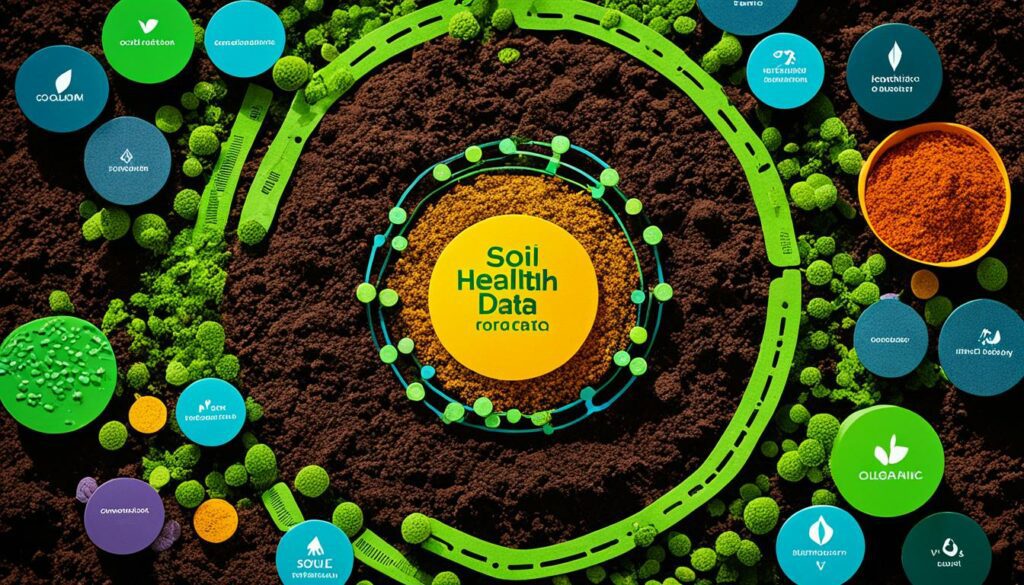
In short, blockchain is changing how we watch and save farm soil. Its easy tracking of traceability in soil health boosts farming’s future. Its safe data tech is key for coming green farming steps.
Artificial Intelligence (AI) is changing how we manage soil health, offering new ways to look at agricultural data. With AI, farmers can get very accurate readings on soil health. This helps them take better care of the land. Such efforts are crucial for feeding the world’s growing population, facing a 24% drop in maize production by 2030.
AI is getting better at analysing soil than older methods. For example, thanks to AI, radar tech might soon make irrigation 50% more efficient. This helps save water while making sure plants get enough to drink. Plus, AI is great at looking at pictures, videos, and listening to data, giving a deeper understanding of soil.
AI helps farmers make better choices about their land. A partnership in Missouri is a great example. They use real-time data to improve their crops. In Europe, the AI4SoilHealth project is doing something similar. It’s creating a system to check soil all across the continent. This will help farmers there too.
Thanks to AI, we’re making farming more sustainable and ready for the future. By using AI’s insights, we can protect our food supplies and handle any problems coming our way.
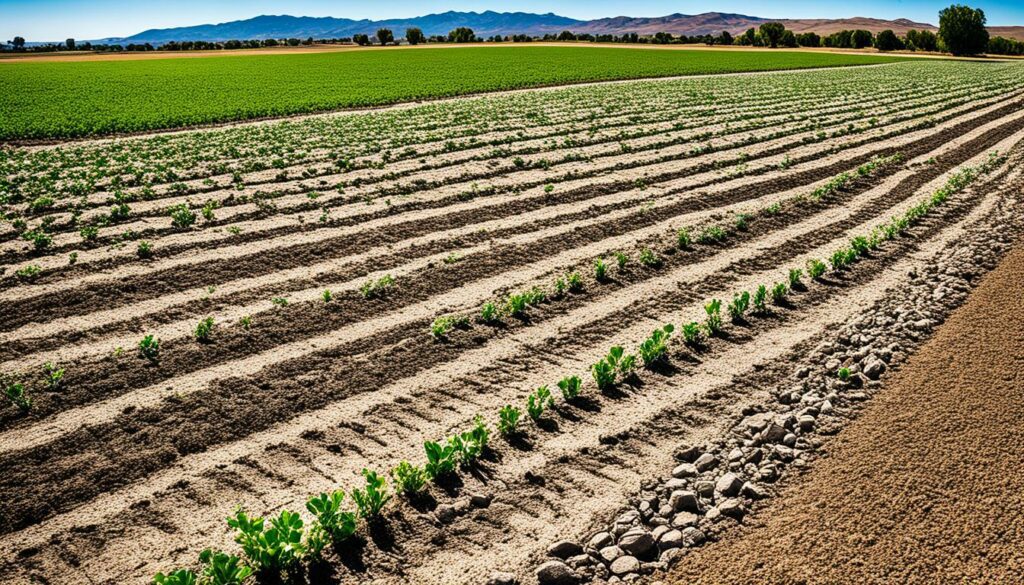
Regenerative agriculture is changing the game in farming. It’s all about making the land better and using it in smarter ways. For instance, by farming this way, we don’t need as many pesticides. This cuts pollution and saves money, making it better for the earth and business. Plus, using these methods can even help farms produce more food.
This new approach can make a lot of money per piece of land, around $530.39 a year. This has got big companies like PepsiCo and Walmart interested. They’re putting in a lot of money, $120 million to be exact, to improve soil and water. They’re using methods like cover crops and rotating crops to achieve this.
But it’s not just about money. Regenerative agriculture also helps the planet. It helps the water cycle and adds more carbon to the soil. These good things make the land healthy and able to keep providing food well into the future.
There are even tests and programs to check if a farm is really doing regenerative farming right. This extra check makes the farming methods more trusted. But there are still some tough parts, like making it work on big farms and proving it really is better through science.
Even though there are hurdles, the benefits in the long run are huge. It can make our farms produce more and be ready for any challenges. So, as we look forward, choosing regenerative farming makes sense for a better and more lasting food system.
| Impact | Details |
|---|---|
| Economic Profitability | $530.39 per hectare per year |
| Pesticide Reduction | 50-100% |
| Soil Carbon Increase | 1-3 tons/ha/year |
| Water Cycle Restoration | Significant improvement |
| Corporate Investment | $120 million by PepsiCo and Walmart |
Looking at soil health trends for 2024 shows a booming economy in agriculture. Market forecasts predict large growth. This is creating great chances for economic success.
The soil treatment market is big, worth US$40.7 billion in 2022. It’s set to hit US$57.1 billion by 2028, growing at 4.5% yearly. Tools like nitrogen fixation are cutting costs and environmental harm, attracting investors. Also, new methods in potassium solubilisation are making plants stronger, opening more chances for agricultural investments.
Equipment for testing soil was worth US$4.1 billion in 2023. Its value is expected to grow by over 7% each year. By 2029, it could be US$19.02 billion. This growth is due to the need for smart farming, powered by AI, which got a lot of investment last year. Plus, with the Federal Reserve planning to lower interest rates in 2024, more funds will go into farming equipment and projects, helping the market.
The USDA also foresees that it will cost less to produce crops like corn, soybeans, and wheat in 2024. This makes soil health technologies more affordable. Costs like interest payments per acre may drop by 30%. Also, the prices of fertilizers and chemicals might go down by 17% and 8% respectively. So, the financial side of farming for 2024 looks bright.
If you’re an investor or someone interested in farming, watch these trends. They show big chances in agriculture and a growing soil health market.
The future of farming that cares for the Earth is closely connected to improving soil health. The market for soil treatments is growing fast. It’s set to jump from US$40.7 billion in 2022 to US$57.1 billion by 2028. This is a steady increase of 4.5%.
Also, the demand for soil testing tools is rising. Valued at US$13.72 billion in 2022, it aims to hit US$19.02 billion by 2029. This progress is key for better farming practices.
Using new tech like nitrogen fixing and potassium solubilization, we’re cutting back on harmful chemicals. This helps in nutrient uptake by plants. Methods to balance soil pH and health are essential too.
Dealing with soil pollution, especially from heavy metals, is vital for protecting the environment. We need special methods to clean and protect our soil.
Looking ahead, systems for smart irrigation and detailed farming data are on the rise. They make farming more efficient and eco-friendly. Technologies like AI and autonomous machines also help with work and boost productivity.
Blockchain and AI are transforming the farming sector. They promise a bright future for farming that takes good care of the Earth. Our shared goal to look after the soil, together with these innovations, will help make our planet a better place for those to come.
In 2024, exciting trends in soil health use technologies like IoT, immersive tech, and robotics. They’re making soil management smarter. These techs are changing how we check soil quality, push green farming, and deal with climate change better.
The IoT helps with soil care by giving real-time data from the ground. Sensors in the soil watch moisture, temperature, and humidity. This lets farmers use water and fertilisers more carefully.
Drones and satellite pics help see soil problems from above. They find erosion, pests, and nutrient needs quickly. These images help treat soil better, leading to more crops and healthier soil.
With high-tech analysis, we can see deep into the soil. It checks moisture and carbon, key for healthy soil. This analysis guides how we use fertilisers and farm sustainably.
In 2024, more people are choosing organic farming. This kind of farming is gentle on the Earth. It helps keep the land fertile and supports diverse life forms.
Biodiversity in soil is vital for nature and farming. It helps with nutrients, controls pests, and makes soil strong. Keeping soil rich in life is key for farming food and protecting nature.
Soil amendments boost soil and help plants grow strong. They stop erosion and save water. Using these helps with farming that lasts a long time.
They play a big part in making our approach to farming eco-friendly.
Better soil health plans save money by cutting chemical needs. They help use resources well and grow more food. This means more profit for farmers and less harm to the planet.
The soil monitoring market is set to hit about USD 1598.78 million by 2030. This growth comes from better technologies improving farming. Things like IoT and soil analysis are helping farmers work smarter.
Good soil health is key for dealing with climate change. It helps with droughts and floods by managing water well. Healthy soil supports plants in tough weather, making farming more resilient.
Many chances to invest in soil health are coming up with new tech and green practices. People can look into IoT, better fertilisers, aerial views, and soil predictions. These areas are set to grow in the farming industry.
Blockchain can change the way we watch over soil health. It offers secure, clear records that are trustworthy. This helps farmers and others make better choices for the land.
AI is changing how we look after soil by diving deep into data and giving smart advice. It can guess conditions and sift through lots of info. This helps farmers do their job better and greener.
Regenerative farming uses methods like less ploughing, more plant variety, and careful soil management. These ways help the soil help itself, boosting its health and fighting climate change.